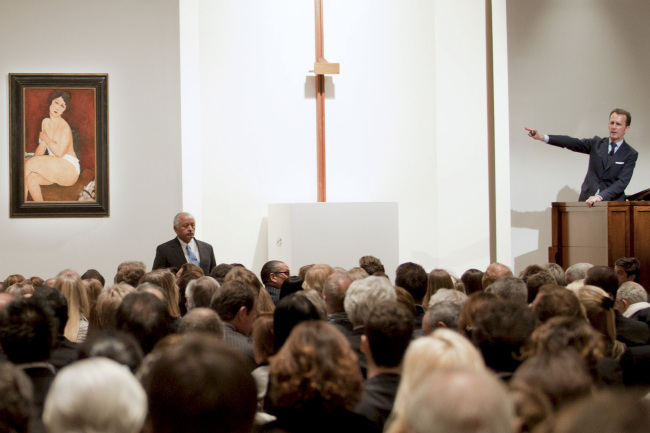Given the current low interest rates, negative rates, low inflation and slow growth, investors are in search of alternative investment products that offer higher returns than savings.
Stocks and equity funds are ideal during low inflation, but can be volatile when unpredictable forces suddenly catch markets off guard.
Gold and U.S. dollars are attractive assets in times of uncertainties, in addition to bonds that can offer steady monthly returns.
 |
Bids are placed on “Nu assis sur un divan (La Belle Romaine),” a painting by Amedeo Modigliani, during Sotheby’s Impressionist & Modern Art sale in New York.(Bloomberg) |
Real estate is expensive, and still recovering from a prolonged slowdown. Some asset managers offer funds investing in commodities such as wine.
Among these, artworks such as paintings and sculptures are emerging as an alternative investment asset amid the recent popularity of “Dansaekhwa,” or Korea’s 1970s monochrome paintings, that has boosted the local auction landscape over the last two years.
“Arts are relatively less sensitive to external economic factors compared to other investment-grade assets. It is not like a Pablo Picasso painting will drastically lose its value when the global economy becomes vulnerable,” said Lim Eun-hye, an analyst at Samsung Securities.
“The value of fine arts follow trends and popularity, rather than market forces.”
In close historical comparison, their value almost moves in tandem with that of real estate, industry sources and analysts say, as those who have the money can invest in these two assets.
Fine art auctions are still considered mostly exclusive for the rich in the U.S. and Europe where global auction platforms such as Christie’s in London and Sotheby’s in New York dominate.
Art auctions account for 0.1 percent of growth in the U.S. and Europe, according to Samsung Securities.
In Korea, the market for fine arts is still in its infancy. Local auctions account for 0.02 percent of growth.
Korea needs to track more transactions -- such as art trade between galleries – in a similar way to stocks traded over the counter so that data can be produced to establish a concrete market like the benchmark KOSPI, said Jeon In-tae, professor of financial engineering at the Catholic University of Korea.
Along with the Korea Art Price Appraise Association, Jeon has been seeking over the years to develop an index that can measure and average the value of tradable and auctioned artworks.
“The first issue at hand is trying to make art transactions as transparent as possible to create a market. At the same time, Korea needs to promote a positive image of Korean art overseas so that foreign investors can come to this market like we see in the capital market,” Jeon said.
Jeon said that this would further increase interest in art in society, and can lead the financial sector to introduce funds that invest in artworks for the public.
However, like stocks and bonds, investing in art can be risky when investors do not do their research or educate themselves about history, appreciation and artists.
“The real value of art is not measured by how much they are sold for at auctions, but by the story, the philosophy and the aesthetics they carry,” said an official of the Korea Art Price Appraise Association.
By Park Hyong-ki
(
hkp@heraldcorp.com)








